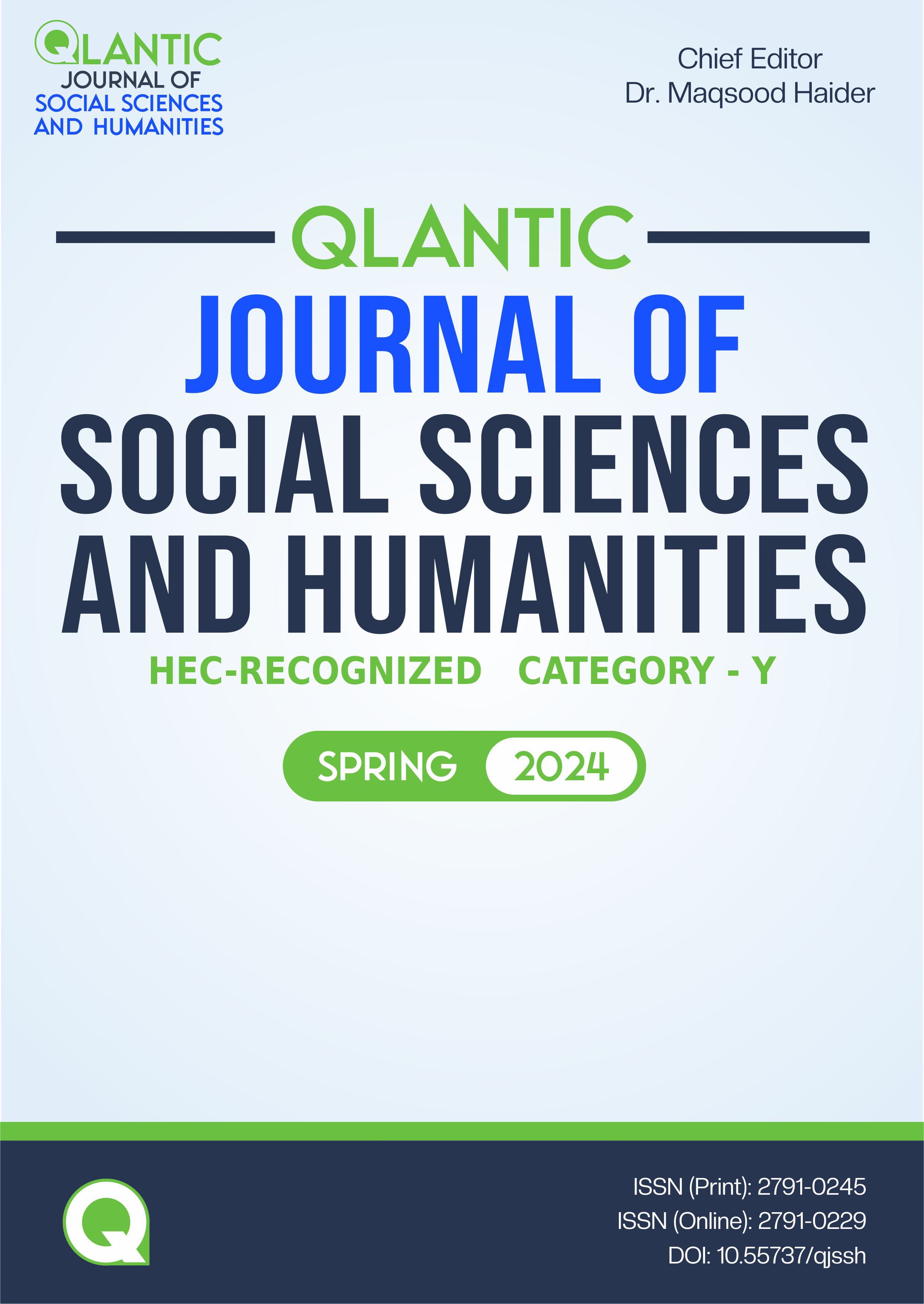Influence of Pakistani Dramas on the Mental Health, Quality of Life and Psychological Well-Being of Female University Students
DOI:
https://doi.org/10.55737/qjssh.591369466Keywords:
Pakistani Dramas, Mental Health, Quality of Life, Psychological Wellbeing, University StudentsAbstract
The history of the drama industry traces back to rich literature, notably beginning in 1964 when PTV emerged as the pioneering channel for broadcasts and transmissions. A recent study delved into the influence of Pakistani dramas on the mental health, psychological well-being and QOL(quality of life) in female university students. Using a cross-sectional research design with quantitative methods, the study recruited a sample of 300 participants through a purposive sampling technique. Data was collected by the application of a self-developed demographic sheet and standardized scales: the Young Mental Health Scale, Ryff's Psychological Well-Being Scale, and Jhon Flanagan's Quality of Life Scale. Both descriptive and inferential statistics were employed for data analysis, revealing a significantly positive correlation (r = .354, p < .000) among the studied variables. In conclusion, the study explored how Pakistani dramas impact mental health, well-being, and quality of life. Educators and mental health professionals can use these findings to better support students in managing developmental challenges and promoting overall well-being. Recommendations include integrating media literacy education into university curricula to empower students to critically engage with media content. Moreover, mental health programs should incorporate strategies to mitigate any potential negative effects of media consumption on students' well-being.
References
Adnan, S., Yousaf, A., & Gillani, S. (2019). Impact of Pakistani Dramas on Youth’s Social Values. Journal of Social Sciences and Humanities, 28(1), 147-156.
Baig, S. (2011). Concept of well-being in Islam: An analysis of Pakistani dramas. Journal of Islamic Studies, 22(2), 147-164. http://dx.doi.org/10.1007/978-3-319-39101-4_5
Ball-Rokeach, S. J., & DeFleur, M. L. (1976). A Dependency Model of Mass-Media Effects. Communication Research, 3(1), 3–21. https://doi.org/10.1177/009365027600300101
Bandura, A., Ross, D., & Ross, S. A. (1961). Transmission of Aggression through Imitation of Aggressive Models. The Journal of Abnormal and Social Psychology, 63(3), 575–582. https://doi.org/10.1037/h0045925
Diener, E., Suh, E. M., Lucas, R. E., & Smith, H. L. (2000). Subjective well-being: Three decades of progress. Psychological Bulletin, 126(2), 276-302. http://dx.doi.org/10.1037/0033-2909.125.2.276
Edwards, A. W. (1970). The measurement of psychological well-being. In A. W. Boyer & W. J. McGuire (Eds.), Persons in the social environment (pp. 167-183). New York: Pergamon Press.
Kamran, A., Khan, H., & Fatima, U. (2023). Exploring the impact of Pakistani dramas on women’s cognitive perspectives and quality of life. Journal of Media Psychology, 35(1), 1-12. https://doi.org/10.1027/1864-1105/a000345
Karim, A. (2016). Understanding well-being from an Islamic perspective. Journal of Muslim Mental Health, 10(1), 55-73. https://doi.org/10.3998/jmmh.10381607.0010.104
Katz, E., Blumler, J. G., & Gurevitch, M. (1973). Uses and Gratifications Research. Public Opinion Quarterly, 37(4), 509–523. https://doi.org/10.1086/268109
Khan, H., Gh̲aniA., & Cheema, M. (2023). Influence of Pakistani Tv Channels on Language and Dressing of Women: A Study of Geo and Hum Tv Dramas. Journal of Professional Research in Social Sciences, 10(01), 53–75. https://doi.org/10.58932/mula0005
Khan, H., Kamran, A., & Fatima, U. (2020). Pakistani dramas and student well-being: A study of media representation, self-perception, and coping strategies. Journal of Television and Media Studies, 8(2), 123-140.
Khan, M. K., Malhi, A. T., Ali, G., & Manzoor, H. (2023). Cultural Effects of Urdu Dramas of GEO and HUM TV among University Students of Narowal. Human Nature Journal of Social Sciences, 4(3), 35-45. https://hnpublisher.com/ojs/index.php/HNJSS/article/view/15
Manzoor, S., Jabeen, S., & Hanif, S. (2019). Impact of Pakistani dramas on mental health of young adults. Pakistan Journal of Social and Clinical Psychology, 17(1), 33-38.
Shabir, A., Safdar, S., & Imran, M. (2018). Social media defy spiral of silence theory and provides baseline for new spiral of social media theory: Ground perspective. Pakistan Journal of Social Sciences, 39(4), 1549-1558. https://pjss.bzu.edu.pk/index.php/pjss/article/view/783
Shah, S. I. A., & Bhatti, M. A. (2013). Well-being and quality of life in Islamic perspective. Journal of Management Research, 5(4), 234-244.
Young, S. L., & Bullock, W. A. (2003). The Mental Health Recovery Measure (MHRM) scale: A revision of the MHRM. Journal of Mental Health, 12(3), 267-277. https://10.1080/0963823031000118244
Young, S. L., & Ensing, D. S. (1999). Exploring recovery from the perspective of people with psychiatric disabilities. Psychiatric Rehabilitation Journal, 22(3), 219–231. https://doi.org/10.1037/h0095240
Published
Issue
Section
License
Copyright (c) 2024 Salbia Abbas, Fajar Sattar, Kaneez Rubab, Noor Ul Ain Fatima

This work is licensed under a Creative Commons Attribution-NonCommercial 4.0 International License.





